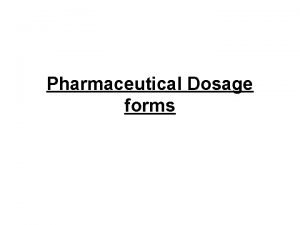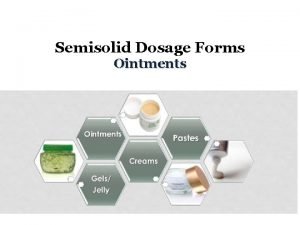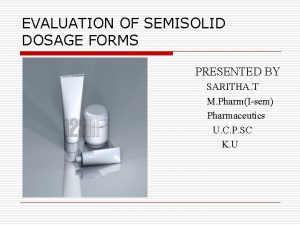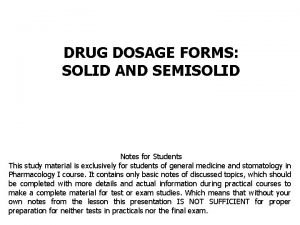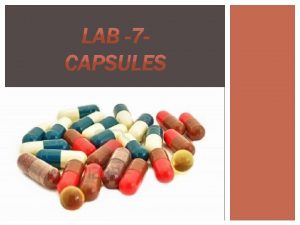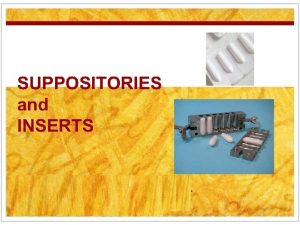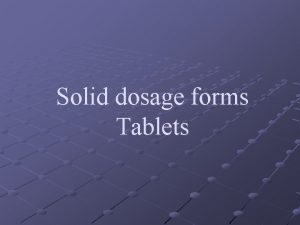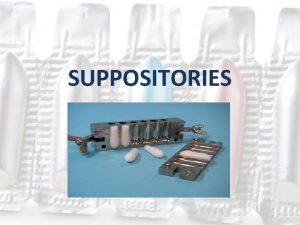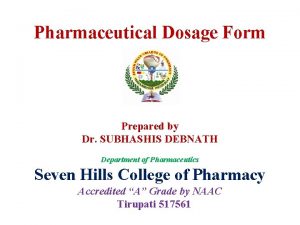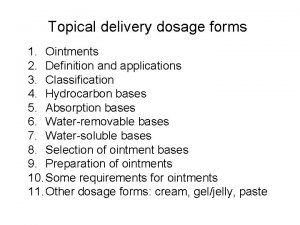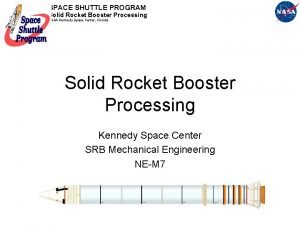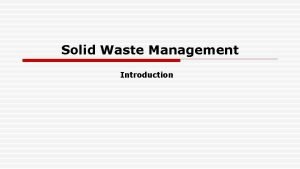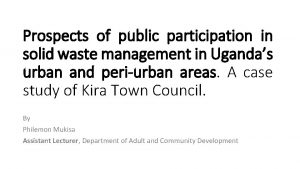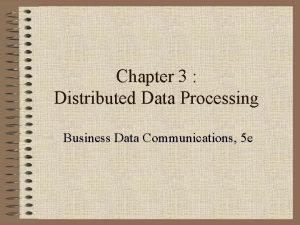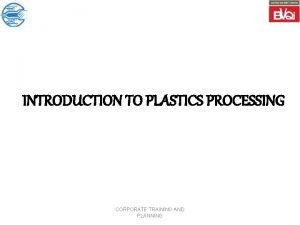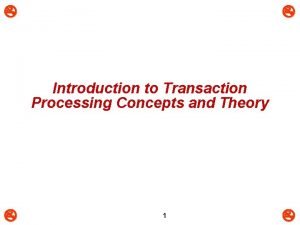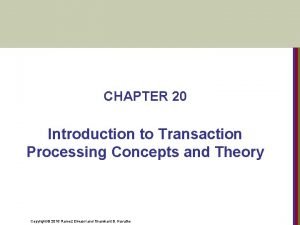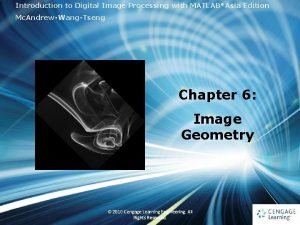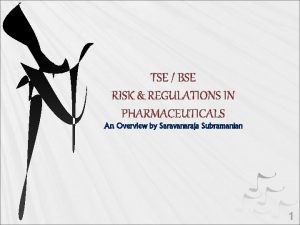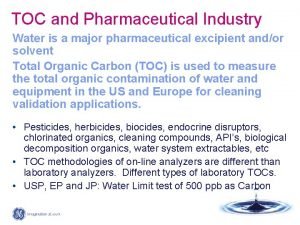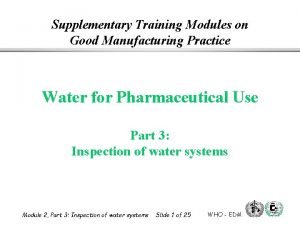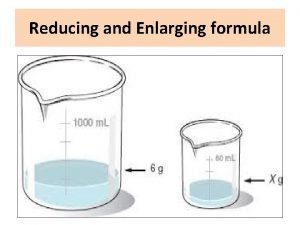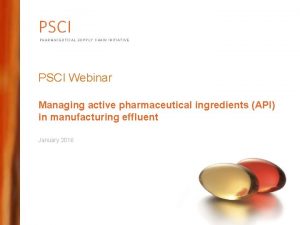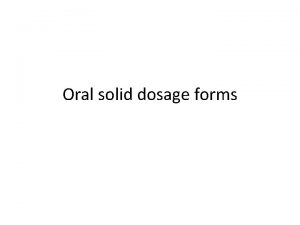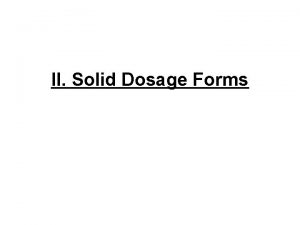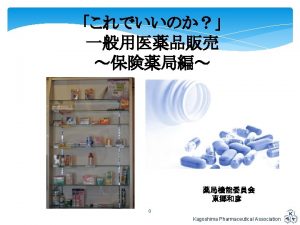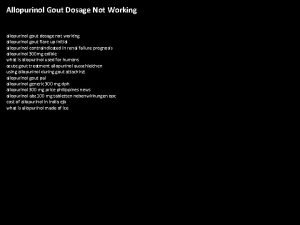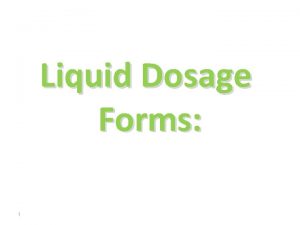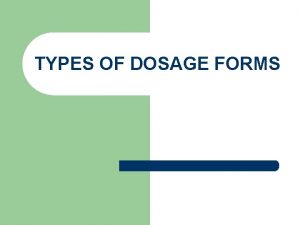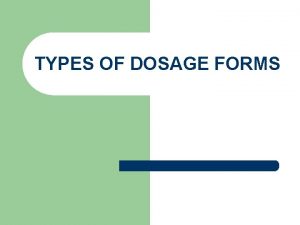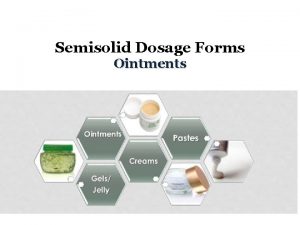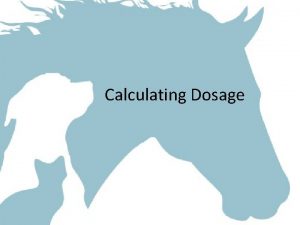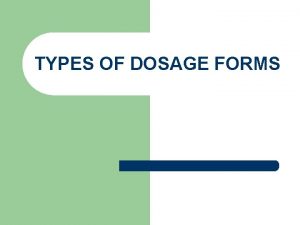Introduction to Solid Dosage Processing Stages of pharmaceutical




























































- Slides: 60

Introduction to Solid Dosage Processing

Stages of pharmaceutical manufacturing Finished Product API Primary Packaging API Excipients Starting Materials (Chemicals) Secondary Packaging

Drug product manufacture API Excipients milling oven drying blending crystallization filtration Direct compression lubrication Wet granulation Dry granulation / milling tableting coating Fluid Bed Dryer Process combines the drug and excipients into the dosage form imprinting Dosage Form

Solid dosage processing • Dosage forms § Quality factors • • Excipients Particle properties Processing routes Unit operations § Size reduction (milling) § Blending § Dry granulation (roll compaction) § Wet granulation § Drying § Tablet compaction § Coating

Solid dosage forms • Oral • Inhaled § Tablets • • • Lozenges Chewable tablets Effervescent tablets Multi-layer tablets Modified release § Aerosol • Metered dose inhalers • Dry powder inhalers § Capsules • Hard gelatin • Soft gelatin § Powders Singh, Naini (2002), Dosage Forms: Non-Parenteral, Encyclopedia of Pharmaceutical Technology

Quality factors for solid dosage forms Functional quality factors -Disintegrates to desired size quickly -The constituent particle size of the dosage form should dissolve and be absorbed in the GI tract at a pre-determined rate Physical quality factors -Must not break up on processing, packaging, transportation, dispensing or handling -Surface of tablet or capsule must be free of defects -Must be stable under anticipated environmental conditions -Have the same weight and composition for each tablet or capsule Sensorial quality factors -Easy and pleasant to swallow Fung and Ng (2003), AICh. E Journal, 49(5), 1193 -1215

Models at different scales Scale Subject Problems Enterprise Business process Sourcing, contract manufacturing, capacity planning Plant Process synthesis, simulation, development Generation of process alternatives, process optimization Equipment selection, performance, sizing, costing Mixing, classification, granulation, milling Continuum Flow and handling of powders Granular flow Particle attributes: composition, size distribution, density, strength, shape Interparticle forces, breakage Molecule Enantiomers and polymorphs, material properties Polymorph prediction, prediction of physical and chemical properties Ng (2002), Powder Technology, 126, 205 -210

Product and process functions • Product function Product property = F(particle properties, formulation) § Product property: Content uniformity, dissolution, flowability, dust formation § Particle Properties: Particle size, particle shape, surface characteristics • Process function Particle properties = F(process parameters, raw material/intermediate properties) § Process parameters: Type of unit operation, operational parameters

Particle properties Product property = F(particle properties, formulation) Potential Impact Processing Behavior Product Quality Factors Property Flow Blending Wetting Drying Mechanical Dissolution Stability Particle Size X X X X Surface Area X X X X Particle Shape X Surface Energy X X X Bulk Density X Pore Size X X X Internal Friction X X Wall Friction X X Hygroscopicity X X Hlinak et al, Journal of Pharmaceutical Innovation, 1 (2006) X

Mean particle size and flowability Bodhmage, A. (2006). Correlation between physical properties and flowability indicators for fine powders. MS Thesis, Department of Chemical Engineering, University of Saskatchewan.

Size distributions for various powders Bodhmage, A. (2006). Correlation between physical properties and flowability indicators for fine powders. MS Thesis, Department of Chemical Engineering, University of Saskatchewan.

Powder flow and tablet weight variations Hancock, Bruno (2007). Dosage Form Specific Tests. Short course on Material Properties, Purdue University.

Excipients are substances, other than the active drug substance, or finished dosage form, that have been appropriately evaluated for safety and are included in drug delivery systems: • To aid in the processing of the drug delivery system during its manufacture; • To protect, support, or enhance stability, bioavailability or patient acceptability; • To assist in product identification; • To enhance any other attribute of the overall safety, effectiveness, or delivery of the drug during storage or use. USP, General Information Chapter <1078>, Good Manufacturing Practices for Bulk Pharmaceutical Excipients

Excipient functions Component Function Examples Fillers Increase size and weight of final dosage form Microcrystalline cellulose, sucrose Binders Promote particle aggregation Pregelatinized starch, hydroxypropyl methylcellulose Disintegrants Promote break down of aggregates Sodium starch glycolate Flow Aids Reduce interaction between particles Talc Lubricants Reduce interactions between particles and surfaces of processing equipment Magnesium stearate Surfactants Promotes wetting Sodium lauryl sulfate, Polysorbate Modified Release Agents Influences the release of active Hydroxypropyl methylcellulose, Surelease, Hlinak (2005)

Most popular excipients • • • Magnesium stearate (lubricant) Lactose (compression aid) Microcrystalline cellulose (compression aid) Starch (corn) (compression aid) Silicon dioxide (glidant) Stearic acid (lubricant) Sodium starch glycollate (disintegrant) Gelatin (binder) Talc (film coating adjuvant, glidant) Sucrose (sweetener, coating) Calcium stearate (lubricant) • • • International pharmaceutical excipients council of the americas, http: //www. ipecamericas. org/public/faqs. html Povidone (binder) Pre-gelatinized starch (binder) Hydroxypropylmethylcellulose (film coating, binder) OPA products (film coats and dyes) Crosscarmelose sodium (disintegrant) Hydroxypropylcellulose (binder, film coating) Ethylcellulose (enteric coating) Dibasic calcium phosphate (compression aid) Crospovidone (disintegrant) Shellac and Glaze (coating agent)

Processing routes Direct Compression Drug Diluent Glidant Disintegrant Dry Granulation Drug Diluent Lubricant Mixing Compression Comminution Wet Granulation Drug Diluent Mixing Wetting Binder Solvent Granulation Drying Lubricant Tablet Compression Disintegrant Glidant Lubricant Screening Mixing Fill die Compress Tablet Coating, Packaging etc. . Disintegrant Glidant Lubricant Screening Mixing Other Routes Fluidized bed granulation Extrusion / rotary granulation

Unit operations • Process function Particle properties = F(process parameters, feed/intermediate properties) § Process parameters: Type of unit operation, operational parameters • Type of unit operation § Size reduction (Milling) § Blending § Dry granulation (Roll compaction) § Wet granulation § Drying § Tablet compression § Coating

Unit operations • Size reduction (milling) § Advantages and disadvantages § Forces in milling § Milling equipment (dry milling) § Media mills (wet milling) § Mill selection § Energy requirements

Particle size reduction Benefits • Mixing is more uniform if ingredients are roughly the same size • Milling of wet granules can promote uniform and efficient drying • Increased surface area can improve dissolution rate and bioavailablity • Improved content uniformity of dosage units Disadvantages • Excessive heat generation can lead to degradation, change in polymorphic form • Increase in surface energy can lead to agglomeration • May result in excessive production of fines or overly broad particle size distribution

Forces in milling • Shear (cutting forces) • Compression (crushing forces) • Impact (high velocity collision) • • Griffith theory T = Tensile stress Y = Young’s modulus ε = Surface energy c = fault length Rumpf (1965), Chem Ing Tech, 37(3), 187 -202

Milling equipment – screen mills • Critical parameters for a conical screen mill § Screen Hole Size/Shape § Impeller Type § Impeller Clearance § Speed • Evaluate impact on aspirin granulation § Particle size reduction § Milling time and energy requirements § Overall milling performance • Milling Work Index = Size reduction / Milling work • Milling Time Index = Size reduction / Milling time Byers, Peck (1990), Drug Dev Ind Pharm, 16(11), 1761 -1779

Milling equipment – screen mills • Screen hole size has largest impact on particle size reduction, milling time and energy requirements Milling work index= Particle size reduction / Milling work • Milling work index significantly lower for smaller screen hole sizes • Impeller type has largest effect on overall milling performance • Impeller clearance not significant at small clearances • Milling work index lower at higher mill speeds § Deflection of material away from screens Byers, Peck (1990), Drug Dev Ind Pharm, 16(11), 1761 -1779

Milling equipment – impact mills • Significant wear on surfaces • Hammer mills § Medium to coarse size reduction § Peripheral speed 20 -50 m/sec • Pin mills § Peripheral speed up to 200 m/sec § Capable of fine grinding § Can be used to mill sticky materials

Milling equipment – jet mill • Superfine to colloid size reduction • Can be used for heat sensitive products • Different configurations § Pancake (spiral) jet mill • Fines exit from center § Loop/oval jet mill • Fines exit from top § Opposing jet mills • Particles impact each other in opposing jets § Fluidized bed jet mill • Particles are jetted towards center (low wear on equipment) § Fixed/moving target jet mills • Particles impact on surface of target (wear can be significant)

Milling equipment – stirred media mill • Critical parameters § Agitator speed § Feed rate § Size of beads § Bead charge § Density of beads § Design of blades § Mill chamber § Residence time

Mill selection Wibowo and Ng (1999), AICh. E Journal 45 (8) 1629 -1648

Energy based analysis – ball mill • Macroscale energy-size relationships (Chen et al. , 2004) § Calculate specific energy for a given size reduction § Functional form derived from theoretical considerations § Rittinger’s model • Energy required for particle size reduction is proportional to the area of new surface created § Kick’s model • Energy required to break a particle is proportional to the ratio of the particle volume before reduction to the volume after reduction Chen et al. (2004), J Pharm Sci, 93(4), 113 -132

Energy based analysis – ball mill Kick’s Law High loading Low frequency Rolling attrition Attrition Rittinger’s Law Low loading High frequency Impact fragmentation Fragmentation Size Reduction of α–Lactose Monohydrate in a Ball Mill Chen et al. (2004), J Pharm Sci, 93(4), 113 -132

Unit operations • Blending § Blending equipment § Impact of size difference § Radial vs axial mixing

Blending – diffusion mixing • Critical parameters § Blender load § Blender speed § Blending time V-Blender Cross Flow Blender Bin Blender Double Cone Blender

Blending – convective mixing Orbiting Screw Blenders Ribbon Blenders Forberg Blenders Planetary Blenders Vertical High Intensity Mixers Horizontal Double Arm Blenders Horizontal High Intensity Mixers Diffusion Mixers with Intensifier/Agitator

Size difference and mixing uniformity Campbell and Bauer (1966), Chem Eng, 73, 179

Mixing in a bin blender – axial mixing Composition after 30 revolutions (10 rpm, 60%fill, w/o baffle) Sudah et al. (2002), Powder Technology, 126, 191 -200

Mixing in a bin blender – radial mixing Composition after 30 revolutions (10 rpm, 60%fill, w/o baffle) Sudah et al. (2002), Powder Technology, 126, 191 -200

Unit operations • Dry granulation (roll compaction) § Critical parameters § Johanson’s theory § Feed system § Impact of granulation on flow properties • Wet granulation § Monitoring liquid addition • Drying § Fluidised bed dryer

Roll compaction • Critical parameters • Advantages § Roll speed and pressure § Improve powder flow § Horizontal and vertical § Reduce segregation feed speed, deaeration § Roll diameter and surface potential § No moisture addition, drying

Johanson’s theory Slip Region Nip Region

Johanson’s theory Slip region Nip region Compressibility Eff. angle of friction Yu et al. (2013), Chem Eng Sci, 86, 9 -18 Wall angle of friction

Johanson’s theory – nip angle Bindhumadhavan et al. (2005), Chem Eng Sci, 60(14), 3891 -3897

Johanson’s theory - stress profile Bindhumadhavan et al. (2005), Chem Eng Sci, 60(14), 3891 -3897

Eff. angle of friction and peak pressure (Johanson’s theory) Eff. Angle of Friction

Eff. angle of friction and nip angle (Johanson’s theory) Nip Angle Eff. Angle of Friction

Effect of lubrication on friction properties Yu et al. (2013), Chem Eng Sci, 86, 9 -18

Effect of lubrication on peak roll pressure Yu et al. (2013), Chem Eng Sci, 86, 9 -18

Effect of lubrication on nip angle Yu et al. (2013), Chem Eng Sci, 86, 9 -18

Impact of feed and roll speed on granule properties Avicel PH 101 Compressibility Mean particle size R R H Falzone et al. (1992), Drug Dev Ind Pharm, 18(4), 469 -489 H

Impact of feed and roll speed on granule properties Hydrous Lactose R=4 R=8 Mean particle size V H Falzone et al. (1992), Drug Dev Ind Pharm, 18(4), 469 -489 V H

Effect of entrained air on feeding and discharging Johanson (1989), Powder Bulk Eng, Februay, 43 -46

Characterization of flowability • Hausner ratio = tapped density / bulk density § Excellent § § § 1. 05– 1. 10 Good 1. 11– 1. 15 Fair 1. 15– 1. 20 Passable 1. 21– 1. 25 Poor 1. 26– 1. 31 Very Poor 1. 32– 1. 37 Extremely Poor 1. 38– 1. 45

Roll compaction and flow properties Before Compaction (poor) After Compaction (excellent) Soares et al. (2005), Dry granulation and compression of spray dried plant extracts, AAPS Pharm. Sci. Tech

High shear wet granulation Chopper Blade Mixer Blade Bowl • Advantages Discharge • Critical parameters § Improve flow § Amount of binder § Improve uniformity § Rate of addition § Increase bulk density § Time of granulation § Enhance resistance to § Speed segregation

Wet granulation – monitoring liquid addition (A) 0. 24 ml/g (B) 0. 36 ml/g nucleation (C) 0. 47 ml/g agglomeration (D) 0. 53 ml/g agglomerate growth Impeller Torque for α–Lactose Monohydrate/MCC granulation Jorgensen et al. (2004), J Pharm Sci, 93(9), 2232 -2243

Wet granulation – monitoring liquid addition (A) 0. 24 ml/g (1 min) (B) 0. 36 ml/g (1. 5 min) nucleation (D) 0. 53 ml/g (2. 25 min) agglomerate growth (C) 0. 47 ml/g (2 min) agglomeration bar = 500 μm SEM of α–Lactose Monohydrate/MCC granules Jorgensen et al. (2004), J Pharm Sci, 93(9), 2232 -2243

Fluid bed drying Damper Outlet Temperature Filter Bag From Granulator Outlet Filter Air Flow Drying Zone Air Flow Product Temperature Retaining Screein To Mill Air Flow Steam Damper Inlet Temperature Condensor Inlet Filter

Unit operations • Tablet compaction § Relative density and compaction pressure • Coating § Objectives § Critical parameters

Rotary tablet press

Relative density changes in manufacture of tablets Hancock et al. (2004), Pharm Tech, April 2003, 64 -80

Equivalence of tablets made with different presses Hancock et al. (2004), Pharm Tech, April 2003, 64 -80

Pan coating Spray Nozzle Rotation Outlet Air Outlet Temperature Dry Air Outlet Filter Air Flow Inlet Temperature Steam Inlet Air Baffle Inlet Filter Air+Moisture • Benefits • Critical Parameters § Mask taste § Air flow § Chemical barrier § Spray § Controlled release § Drum dynamics § Appearance • Rotational speed • Fill fraction

References • Theory and Practice of Industrial Pharmacy, L. Lachman et al. (eds) (1986). • Handbook of Pharmaceutical Granulation Technology, D. M. Parikh (ed), Marcel Dekker (1997). • Pharmaceutical Dosage Forms: Tablets, vol 2, Marcel Dekker (1990). • Encyclopedia of Pharmaceutical Technology, Marcel Dekker (2003). • Perry’s Chemical Engineers Handbook, 7 th Ed. , Mc. Graw Hill (1997).
 Examples of unit dosage form
Examples of unit dosage form Yunitron
Yunitron Yunitron
Yunitron Evaluation of semisolid dosage forms notes
Evaluation of semisolid dosage forms notes Example of physical incompatibility in pharmaceutics
Example of physical incompatibility in pharmaceutics Evaluation test for semisolid dosage form
Evaluation test for semisolid dosage form Pulveres adspersorii
Pulveres adspersorii Capsule.sizes
Capsule.sizes Preparation of suppositories
Preparation of suppositories Advantages of semi solid dosage form
Advantages of semi solid dosage form Semi solid dosage form definition
Semi solid dosage form definition Solid
Solid Define monophasic liquid dosage form
Define monophasic liquid dosage form Topical dosage and delivery
Topical dosage and delivery Dosage form meaning
Dosage form meaning Importance of pharmaceutical inorganic compound
Importance of pharmaceutical inorganic compound Crystalline or amorphous
Crystalline or amorphous Example solid solution
Example solid solution Covalent molecular and covalent network
Covalent molecular and covalent network Crystalline solid
Crystalline solid Crystal solid and amorphous solid
Crystal solid and amorphous solid Crystalline solid and amorphous solid
Crystalline solid and amorphous solid Anisotropic meaning in chemistry
Anisotropic meaning in chemistry When a solid completely penetrates another solid
When a solid completely penetrates another solid Interpenetration of surfaces
Interpenetration of surfaces Evaporation mixture example
Evaporation mixture example Shuttle srb
Shuttle srb Key stages in digital image processing
Key stages in digital image processing Labelling in tissue processing
Labelling in tissue processing Top-down processing
Top-down processing Gloria suarez
Gloria suarez Bottom up processing example
Bottom up processing example Neighborhood averaging in image processing
Neighborhood averaging in image processing Primary processed food
Primary processed food Point processing in image processing example
Point processing in image processing example Histogram processing in digital image processing
Histogram processing in digital image processing Parallel processing vs concurrent processing
Parallel processing vs concurrent processing Laplacian filter
Laplacian filter Point processing in image processing
Point processing in image processing Thinning and thickening in image processing example
Thinning and thickening in image processing example Top down procesing
Top down procesing Batch processing vs interactive processing
Batch processing vs interactive processing Solid
Solid Solid waste disposal introduction
Solid waste disposal introduction Oerdigital
Oerdigital Distributed data processing system example
Distributed data processing system example Introduction to plastic processing
Introduction to plastic processing It was designed as a commercial data-processing computer?
It was designed as a commercial data-processing computer? Introduction to transaction processing concepts and theory
Introduction to transaction processing concepts and theory Disadvantages of dlp projector
Disadvantages of dlp projector Transaction processing in dbms
Transaction processing in dbms Introduction to digital image processing with matlab
Introduction to digital image processing with matlab Tse/bse certificate in pharmaceutical
Tse/bse certificate in pharmaceutical Toc in pharmaceutical industry
Toc in pharmaceutical industry Importance of quality control in pharmaceutical industry
Importance of quality control in pharmaceutical industry Validation of water systems for pharmaceutical use
Validation of water systems for pharmaceutical use Reserve sample definition
Reserve sample definition Pharmaceutical calculation reducing and enlarging formulas
Pharmaceutical calculation reducing and enlarging formulas Pharmaceutical supply chain initiative psci
Pharmaceutical supply chain initiative psci Pharma degree
Pharma degree What goes in black pharmaceutical waste containers
What goes in black pharmaceutical waste containers
